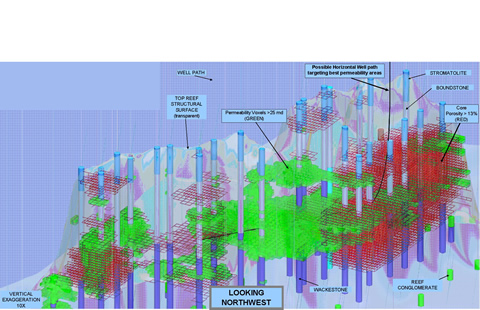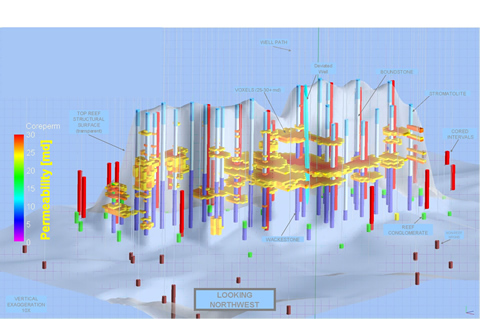The intracratonic basins of North America (the Michigan, Williston, Illinois and Appalachian Basins) contain large numbers of pinnacle reefs (Catacosinos et. al., 1991; Fisher et. al., 1988). In the Michigan Basin, the total number of reef fields discovered exceeds 700, with over 300 million barrels of oil and 2 trillion cubic feet of gas produced. Most of these wells are now shut-in or plugged and abandoned, even though the primary recoveries were only 25 - 40% and they are known to contain large quantities of by-passed oil. Clearly these reefs are valuable resources and obvious targets for enhanced recovery. To date they have not been subjected to many enhanced recovery attempts even though many of them are thought capable of producing a volume of hydrocarbons nearly equal to the original primary recovery, in some cases an additional 250,000 - 500,000 barrels of oil per reef.
Two attempts have been made to produce the Michigan pinnacle reefs by CO2 injection and they appear to have been reasonable successful. Reported additional production due to CO2 injection is 160,000 and 430,000 barrels, respectively. Those volumes represent 14% and 33% of the primary recovery in just 5 years. One of these attempts, at Dover Field in Otsego County, is close to the proposed demonstration well and judging from production data released to the State of Michigan, the CO2 nearly restored the production to initial conditions. However, aside from state-mandated disclosures, the details of the operations have not been made public and this has been a serious impediment to widespread adoption of this technology.
Project Results
A production response of more than 80 barrels of oil per day has resulted from the initial stage of repressurization of a depleted Niagaran pinnacle reef using Antrim waste CO2 that would otherwise have been vented to the atmosphere. Detailed reservoir modeling of Niagaran reefs using the technique of well log tomography is producing a new reservoir characterization tool that can be used for the visualization of permeability and porosity distribution in oil and gas reservoirs.
Benefits
The project is a simple operation that can be widely implemented at a relatively low cost if it can be demonstrated to be economic. It is expected the demonstration well in Otsego County will produce an additional 400,000 to 600,000 barrels of oil that is nearly the original production, and at that rate will be economic. Estimated costs to acquire, compress, inject and recover the oil are about $3 million. The breakeven point would be at about 200,000 barrels assuming $17/barrel oil. An extensive belt around the northern and southern margins in Michigan has proven reef production, with over 700 reefs discovered. Assuming that 100 reefs could be candidates for CO2 injection, and assuming an average recovery of 400,000 barrels, the basin-wide recovery approaches 40 million barrels. For this project, about 17 reefs and 130 wells have been identified in the vicinity of the proposed demonstration well. This region will be evaluated for enhanced recovery potential as part of this project.
Since the CO2 to be injected will come from nearby Antrim production, an additional benefit will be to sequester this CO2 rather than venting it to the atmosphere. In addition to the write-up of the field trial, the Basin reef inventory will be in a digital format with pertinent engineering and geological characteristics. The economics of the process in terms of secondary recovery of hydrocarbons will be evaluated.
Project Summary
Pinnacle reefs have a high vertical relief and are also nearly hermetically sealed. CO2 will be injected into the top of the reef and the hydrocarbons will be collected from a horizontal drain well drilled at the base of the reef.
The CO2 will be obtained from nearby gas wells producing from the Antrim Formation where the gas will be compressed and dehydrated, then piped a short distance (1 mile) to the demonstration well. There it will be injected to bring the reef back to nearly virgin pressure and the re-mobilized hydrocarbons will tend to migrate to the bottom of the reservoir as the gas cap expands. This CO2 is currently vented to atmosphere as a waste product.
Nearby well logs that penetrate the reef will be analyzed using a new approach that has been developed at Michigan Technological University. This approach has been termed Log Curve Amplitude Slicing (LCAS) and uses suites of well logs to map the horizon of interest at 1-foot intervals, essentially utilizing the full information content of the log. The technique is similar to mapping formation tops from log picks or drillers reports except that the attribute is mapped at much more closely spaced intervals (e.g. 1 foot).
In this project, the horizontal resolution is expected to be as good as or better than 3D seismic. LCAS has been used to map the Traverse Formation in the central Michigan Basin using the gamma log. A previous study showed that the gamma ray could be used to map depositional units (low gamma = clean limestone, high gamma = shale, etc.) in a very plausible manner. This study showed that deltas encroached and withdrew from the basin at various times corresponding to events in the hinterlands. There have been several reefs located with multiple wells, up to 20, that can be used in a similar fashion to map reef facies. The wells have multiple logs so a number of attributes can be mapped.
This project will focus on mapping lithology/deposition environment and porosity. If this technique is successful it will provide a useful tool for analyzing reefs and planning production strategies. The methodology has been worked out and applied on a basin scale and this project will use the same technique on a smaller (field) scale with a higher log, or sample, density. A key component to any successful secondary or enhanced recovery operation is detailed reservoir characterization. This project will acquire all available geologic and engineering data for the study area. Cores and core analyses are available for several wells in the study area. Reservoir pressure data was regularly collected throughout the primary phase of production. Monthly and annual production history data is also available. These data along with the wire line log data derived from the LCAS process, will be integrated to build an interactive database and geologic model.





